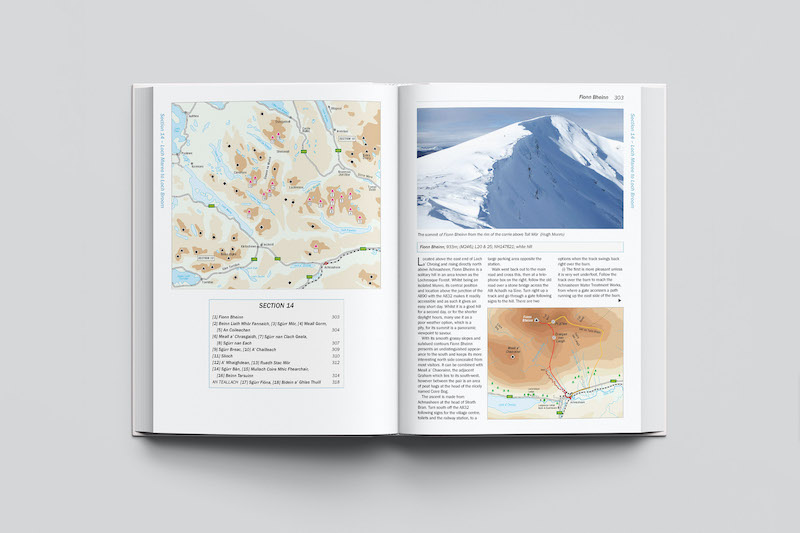This is the fourth edition of The Munros book from the Scottish Mountaineering Club – and the first new edition for 22 years. In brief, it’s a larger and modern looking book with longer descriptions of the routes to and from the summit of the 282 Scottish mountains with a height of more than 3000ft/914m. The book now also details the 226 subsidiary Munro Tops.

First impressions: The Munros book
This is a smart looking book that will appeal to walkers as both a guidebook and a coffee table book.
Just now, when so many people can’t reach the Munros due to the Covid pandemic restrictions, it’s a book that will be longingly lingered over and browsed through.
The fresh look continues throughout the book with great photography and more expansive and updated route details by the authors Tom Prentice and Rab Anderson. They have spent several years working on the book and acknowledgements are also given to contributions of the authors of previous editions.
The book includes full routes to and from the summits, as well as potential extensions and variations. The maps are clear and simple and offer a good guide from which you can then plot your route on the ground by OS Map.
There is a full introduction to the Munros and Sir Hugh Munro over four pages, followed by three pages of book notes. The rear of the book is given over to Munro’s Tables and other useful information.
Profits from the sale of the book go to the Scottish Mountaineering Trust, which is a charity that provides grants to recreation, education and safety projects in the outdoors.
The book is published by the Scottish Mountaineering Press.


Closer look: The Munros book
When I first started walking Munros with my (now) husband, it was Gordie that showed me the routes in his 3rd edition (revised in 2006) of the SMC’s The Munros book. He would plan every walk after poring over the routes and descriptions. (The book is now quite tatty but it looks great because it is obviously well-used.)
I found the book fascinating, but also a bit old fashioned. The maps and the descriptions didn’t seem too helpful for a beginner. Instead, like many other people, I referred to on-line resources, such as Walk Highlands.
Now as a much more experienced Munro bagger I can appreciate the routes in the old SMC book but I far prefer the look and details found in the latest edition.
The book is split into 17 sections by area. Each route is name with a height in metres, as well as a grid reference and the Gaelic translation for the mountain name.
The accompanying map has colour-coded routes. A solid red line is the principal (or more frequented0 route and red dashed lines are variations and extension routes. A yellow, or yellow dashed line, shows secondary routes and extensions.
Munro summits are a solid black triangle, while Munro Tops are a white triangle. For reference, the maps detail other mountains including Corbetts, Corbett Tops, Grahams, Graham Tops and “other summits”.
The descriptions of the routes are much clearer than I recall from the previous edition and also give the total distance, height gain and estimated time for the full route. The Munros book was previously criticised for giving only the time to the summit and not the return or the whole route.
The photos are fantastic and this is a delight because so many of us are craving a bit of Munro magic just now. I found myself flicking through the book, stopping at photos that took my fancy and then flicking on again. It looks like there are far more photos in this edition than the last.

There are also boxes of extra information dotted throughout the book. These also caught my attention as I flicked through the book and they made me stop for a longer read.
In addition, this edition includes details, where appropriate, of routes that might be made faster by cycling the first section. Many people now use bikes on easier-going tracks to cover the first (and last) miles and the book usefully has separate timings so that you can work out how long it might take if you go by bike and also if you choose not to.
I like the book because it offers lots of route options and ideas for extending the routes to take in other summits. While I am still very likely to continue to use Walk Highlands as a resource, it’s great to be able to refer to The Munros guidebook as well for other ideas or combinations of ideas and routes. Perhaps if I do a Munros round again I will take in the Munro Tops as well.
The Munro’s Tables are listed at the back of the book (serving as a book index, too). There is also a table of The Furths (the mountains of Munro height in England, Wales and Ireland) and another table of the Munros and Tops in order of height.
The larger format of the book and the fresh, more modern font makes the book far easier to read. There are an extra 100 extra pages so the book feels more solid and weightier.
Of course, after flicking through The Munros book a few times, I then turned to the pages detailing my final Munros. I have nine to walk to finish my first round. It was brilliant to be able to see and read about the Munros I hope to do sometime this year.
This is a beautifully produced book with a huge amount of fantastic and detailed information on one of my favourite hobbies, Munro bagging.
The book is priced at £30 from Scottish Mountaineering Press.

